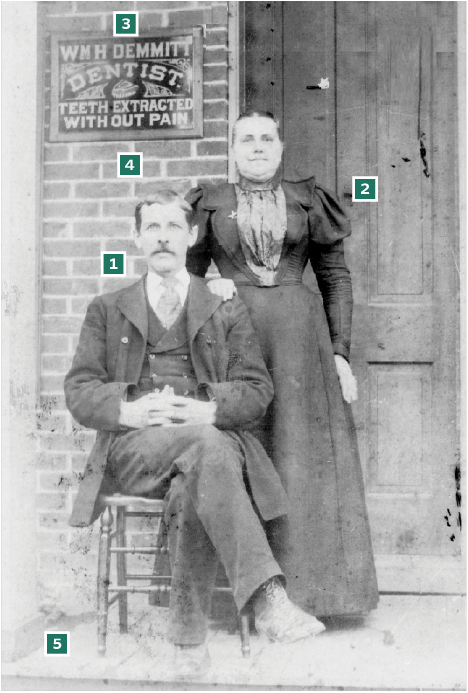Sign up for the Family Tree Newsletter Plus, you’ll receive our 10 Essential Genealogy Research Forms PDF as a special thank you!
Get Your Free Genealogy Forms
"*" indicates required fields
Scratching your head over what your ancestor did for work? The answer is usually in a census or city directory, but it also might be in a photo. The late 19th century saw an interest in capturing people at work and businessmen in formal portraits. Such images hold clues to the kind of business in the tools and attire shown.
In this photo, there’s no doubt about what the subject did for a living. The sign in the background says it all. William Henry Demmitt (1859-1918) posed with his wife, Martha, outside the entrance to his dentist office in Union Bridge, Md. He advertised, “Teeth extracted with out pain.”
The Carroll County (Maryland) Historical Society holds the 1892 edition of Business Review and Directory, Northern, Western, Central and Southern Maryland. According to a biographical sketch, Demmitt had been a dentist of practical experience for 14 years and, while born in Carroll County, he’d returned to the area only in 1886.
Unlike most dental practitioners of the era, who learned through apprenticeships, Demmitt received formal training at the United States’ first dental school, the Baltimore College of Dental Surgery. The College opened in 1840 and in 1923, became part of the University of Maryland at Baltimore. By the time Demmitt earned a certificate in 1879, dentistry had advanced enough that he could create a denture from vulcanite (a type of rubber) and fill teeth with gold. He could use nitrous oxide, ether or chloroform to fulfill the promise on his sign. According dentists’ newspaper ads, the cost of removing a tooth was 50 cents.
Genealogical records fill in more of the story. The Demmitts appear in the 1900 US census in Union Bridge, Md., with their five children aged 10 to 19. Adding up the photo clues tells us that this image was likely taken a few years before that census.

1. Wide silk ties were a common sight in the 1890s, as were neatly trimmed mustaches.
2. The woman’s leg o’ mutton sleeves, silk bodice inset and wide lapels date between the mid-1890s and the late 1890s.
3. Most towns had sign painters who local businesses could hire. Demmitt’s sign includes a small image of a denture. Bold gold lettering on a black wooden background was standard.
4. City directories show that Demmitt’s dental office was located on South Main Street. Fire insurance maps such as those by the Sanborn Map Co. (often available through genealogical libraries) could provide more details about this building and others nearby.
5. The couple poses on an elevated wooden sidewalk. Paved or stone sidewalks were unusual in most communities.
2. The woman’s leg o’ mutton sleeves, silk bodice inset and wide lapels date between the mid-1890s and the late 1890s.
3. Most towns had sign painters who local businesses could hire. Demmitt’s sign includes a small image of a denture. Bold gold lettering on a black wooden background was standard.
4. City directories show that Demmitt’s dental office was located on South Main Street. Fire insurance maps such as those by the Sanborn Map Co. (often available through genealogical libraries) could provide more details about this building and others nearby.
5. The couple poses on an elevated wooden sidewalk. Paved or stone sidewalks were unusual in most communities.
From the January/February 2016 Family Tree Magazine
ADVERTISEMENT

